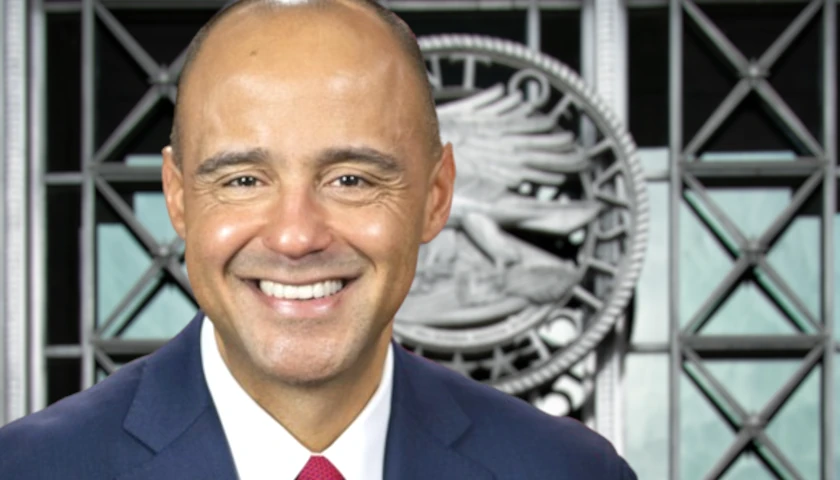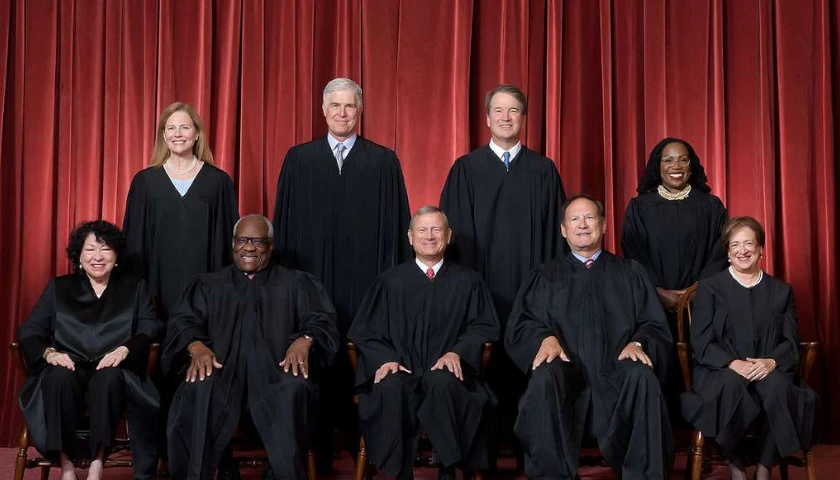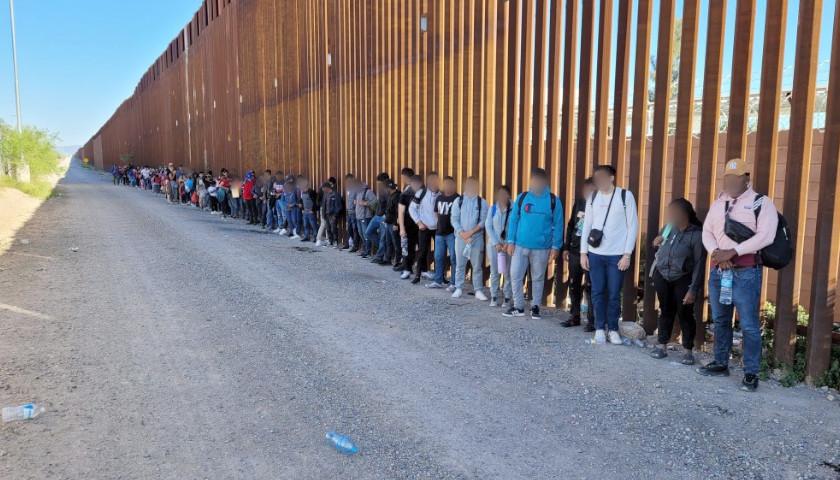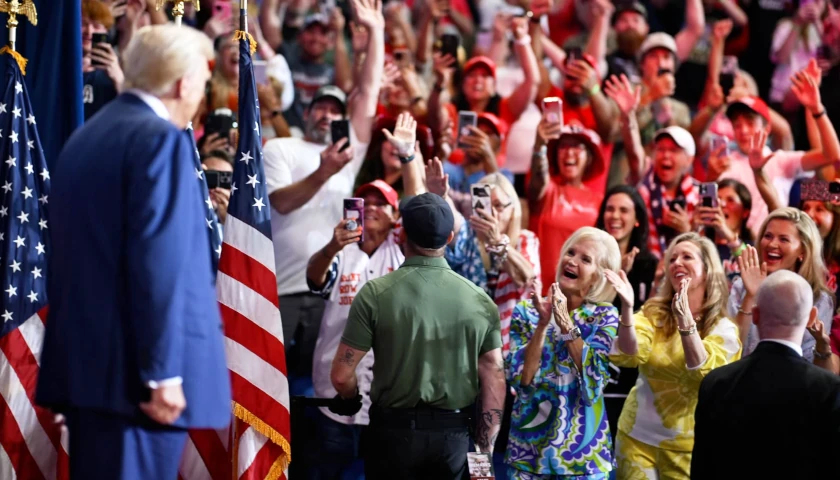Democrats ended their four-day convention on Thursday with a vacuous speech by the party’s installed candidate, Kamala Harris. Her short stint on the main stage made the regime media, which has blessed her with 84 percent positive news coverage since the Pelosi coup according to one analysis, drunk with joy.
Harris, like the roster of speakers before her, spent most of the speech demonizing her general election opponent and repeating one of the party’s most consistent campaign themes: Donald Trump will use his authority to vanquish his foes should he return to the White House. “Consider…his explicit intent to jail journalists, his political opponents, and anyone he sees as the enemy,” Harris claimed.
Other DNC speakers similarly warned that a Trump presidency would result in the mass arrest and incarceration of Democrats. Michigan State Senator Mallory McMorrow warned that Trump “would be able to weaponize the Department of Justice to go after his political opponents.” McMorrow, who must have missed the news of the armed nine-hour raid of Mar-a-Lago in August 2022, further insisted Trump would “turn the FBI into his own personal police force.”
“That is not how it works in America. That’s how it works in dictatorships!” McMorrow shouted.
Now, one can agree with McMorrow and others that the full weight of the federal government’s law enforcement operation should not be used to settle political scores. That sort of thing is indeed the stuff of banana republics.
And it is exactly what’s been happening in America since January 2021.
Not only did the DOJ and FBI open criminal investigations into Donald Trump resulting in two unprecedented federal indictments against a former president, the Biden/Garland/Monaco DOJ prosecuted and imprisoned two of Trump’s longtime confidantes — Peter Navarro and Steve Bannon, who is currently behind bars in Connecticut — and assisted other politically-motivated prosecutions against Trump in New York and Georgia.
The Threat of Attorney General Matthew Graves
Further, the prosecution of Americans who protested Joe Biden’s election on January 6 is active and ongoing. During the course of the DNC convention, U.S. Attorney for the District of Columbia Matthew Graves (pictured above) announced the arrest of seven individuals for their participation in the Capitol protest more than three-and-a-half years ago. (At least half reside in swing states including North Carolina, Michigan, and Pennsylvania, an effective way to keep the “insurrection” in the headlines.)
And as Graves gradually closes in on his promised caseload of 2,000 J6ers — his latest press release boasts that “more than 1,488 individuals have been charged in nearly all 50 states for crimes related to the breach of the U.S. Capitol” — the impeachment report released this week by House Republicans confirmed that Graves refused to consider prosecuting Hunter Biden for tax evasion, something whistleblowers disclosed to Congress last year.
Special Counsel David Weiss asked Graves in early 2022 to partner with his office in bringing charges against Hunter Biden for tax crimes committed in Washington in 2014 and 2015; a decision needed to be made quickly as the statute of limitations was about to expire. But Graves rejected Weiss’ request.
“On March 19, 2022, Graves met with five or six members of his office…where they decided not to partner with Weiss’s office on prosecuting the Hunter Biden case.” As a result of that decision, the report noted, “Weiss was unable to bring charges in D.C.”
Now that sort of brazen bootlicking does not go unrewarded in the nation’s capital, which is precisely why Graves is very likely Harris’ top candidate for attorney general if she wins in November.
And Graves’ cover-up of the Biden family crime racket and the continued prosecution of J6ers aren’t the only reasons why Harris would choose Graves.
All in the Commie Family
Harris appears to be close to Graves’ wife, Fatima Goss Graves, president and CEO of the far-left National Women’s Law Center (NWLC), a $100 million nonprofit headquartered in Washington. According to White House visitor logs, Goss Graves has met with or attended events hosted by Harris on numerous occasions since her husband took the reins of the most powerful U.S. Attorney’s office in the country. (Logs also indicate Graves was at the Biden White House six times in March 2022 including a one-on-one meeting with one of Biden’s senior public engagement advisors at the same time her husband was figuring out how to avoid working with Weiss on the Hunter Biden matter.)
I am thrilled to support @vp. I could not be more excited that she will be the party’s nominee. And I am clear that she will be the first women president of the United States! pic.twitter.com/kEvJwFHxRN
— Fatima Goss Graves (@FGossGraves) July 21, 2024
The bond between both families is strong. Meena Harris, Kamala’s niece, serves on the NWLC board of directors. And Matthew Graves worked at DLA Piper law firm in Washington at the same time as Second Gentleman Doug Emhoff.
They also share the same radical worldview. Goss Graves’ racially oriented organization promotes unlimited abortion, transgender rights including allowing boys to compete in girls’ sports, and mandatory income, housing, child care, and health insurance government supports.
Last year, NWLC launched a program called “Tax the Patriarchy.” The plan identified nearly $3 trillion in new taxes to be spent on a wishlist of redistributive government policies including $650 billion (yes billion) over ten years on “baby bonds,” which would “[invest] money in savings accounts for children from low-income families would combat wealth inequality to benefit those who have historically been left out of wealth-building opportunities like homeownership and higher education.”
But the issue near and dear to Goss Graves’ heart is dismantling the Supreme Court, more specifically, removing Justice Clarence Thomas. She is part of a broad coalition demanding Thomas’ resignation and peddling propaganda about his “ethics” violations. Goss Graves has worked with Senator Sheldon Whitehouse on Supreme Court matters; Whitehouse sent a letter to Attorney General Merrick Garland last month asking for a special counsel to investigate Thomas
An Accelerated EU-Style Crackdown on Free Speech
Given his record of doing Democrats’ dirty work in the U.S. Attorney’s office, one can easily imagine Graves using the attorney general’s office to realize the unhinged fever dreams of his wife and his boss, Kamala Harris.
Would Attorney General Matthew Graves investigate and prosecute conservative Supreme Court justices in an effort to force them to step down?
Would Attorney General Matthew Graves accelerate the criminalization of free speech, an issue Robert F. Kennedy Jr. warned of in his history-making address to the nation on Friday? Would Attorney General Matthew Graves go after private companies who refuse to enforce “woke” policies related to race, gender, and income equality?
Would Attorney General Matthew Graves jail journalists and social media influencers who defied the Harris regime? Would Attorney General Matthew Graves arrest Elon Musk for promoting “disinformation” or something similar to what happened on Saturday to Telegram founder Pavel Durov? After all, Graves’ prosecutors routinely cite inflammatory social media posts as evidence of wrongdoing in J6 cases.
Would Attorney General Matthew Graves continue to protect the political corruption of Democrats as he did in the Hunter Biden case?
The answer to all of the above is yes. Which is why Attorney General Matthew Graves is a terrifying prospect — and a very realistic scenario if Kamala Harris is elected in November.
– – –
Julie Kelly is an independent journalist covering the weaponization of the U.S. Government against her citizens, Follow Kelly on Twitter / X.
Background Photo “Department of Justice Seal” by The United States Department of Justice.





